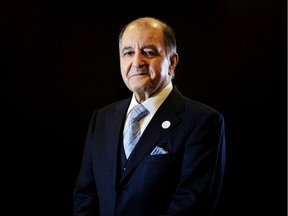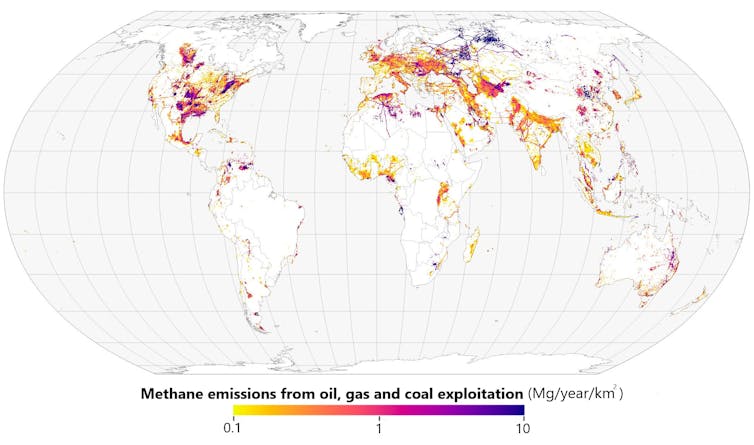Alberta health minister says 4-year-old child among first influenza deaths in province
ANTIVAXXER PREMIER SMITH SEZ
NO MASKS IN SCHOOLS
Death comes as children’s hospitals face treating a deluge
of sick kids
In a social media post on Thursday evening, Alberta's health minister said the province is reporting its first influenza-related deaths of the season.
Among those dead is a four-year-old child, Alberta Health Minister Jason Copping wrote in a tweet.
Copping said he would not be providing additional identifying details due to privacy, so the child's gender and location is unknown.
"I would like to extend my condolences to their family and loved ones at this difficult time," Copping wrote.
"This season, as we see influenza virus circulate through the province at higher levels, we can again expect to see an increase in severe outcomes."
Alberta Health data shows that as of Nov. 12 there have been six flu deaths in the province.
The child's death comes at a time when many Alberta students are home sick with respiratory illnesses, including the flu, COVID-19, and RSV, and as children's hospitals in Alberta are under intense pressure as they deal with an influx of sick kids.
Doctors at the Alberta Children's Hospital in Calgary and the Stollery Children's Hospital in Edmonton are battling a deluge of viral illnesses.
"I appreciate this news is distressing for parents and guardians, and many may be looking for guidance on how to protect their children from becoming ill," Copping tweeted.
Copping said he advises all Albertans to get their flu slot — he also recommended people stay home when sick and wear a mask to reduce the risk of infection.
Alberta Health data states there are 34 people in the ICU with an influenza infection, and 355 people hospitalized, as of Nov. 12.
There have been 2,082 laboratory-confirmed cases this year.
Mask-use harms among children debated
as Calgary Board of Education posts high
absenteeism rates
Stephanie Thomas
CTV News Calgary Video Journalist
Follow | Contact
Updated Nov. 17, 2022
As rapidly spreading respiratory illnesses are causing many Calgary students to miss school, Alberta's political leaders remain opposed to reintroducing mask mandates in schools, even saying they cause harm to children.
Yet some health experts say there's little evidence of the downsides, and are encouraging parents to make choices to keep their kids safe.
The Calgary Board of Education (CBE) is now posting daily updates with the rate of absenteeism for illness among its student population.
"There are a lot of viruses going around and kids are getting sick," said Christine, a mom of a student at Alexander Ferguson School, which has an absentee rate of 26.9 per cent as of Thursday.
She added, "Unfortunately I feel like it's the little kids that are taking the brunt of it but hopefully it passes."
At least three other CBE schools have rates near 30 per cent.
Overall, the board of education says 11 per cent of K-12 students are missing class for sickness.
On its website the CBE says "we will continue to internally monitor student and staff absences this school year. It may still be necessary to transition individual classes or grades to at-home learning as required due to operational challenges. Families will be notified by their school in the event their child's class is impacted."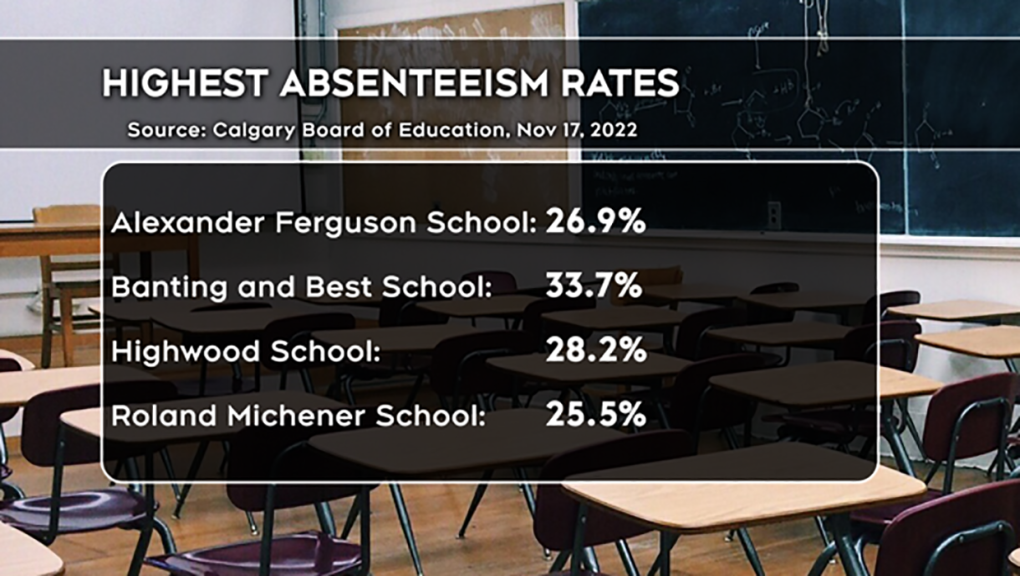
PUSHBACK AGAINST MASKS
On Wednesday the education minister pushed back against reintroducing mask mandates in Alberta schools, saying they were linked with poor mental health outcomes.
"I also hear from parents, and teachers and children themselves, that it was the masking that contributed to those challenges. And to those feelings of anxiety, some have had issues with breathing properly learning properly," said Adriana Lagrange.
Earlier this week Premier Danielle Smith also announced opposition to resuming mask requirements in schools, sayings it's a choice individuals and their children are free to make.
The province lifted mask requirements last spring but internal provincial documents released by court-order showed the data supporting claims masks are harmful to children included several opinion columns, surveys, or comparisons to jurisdictions very different from Alberta.
"I think that (the premier and education minister) can make whatever policy choices they want to make as elected officials, but they can't lie to the public about the science," said Lorian Hardcastle, health and law professor at the University of Calgary.
She says the evidence that masks are physically harmful, cause behavioural and developmental delays are "myths" and unbalanced against science about the efficacy of mask-wearing to slow the spread of viruses like COVID-19.
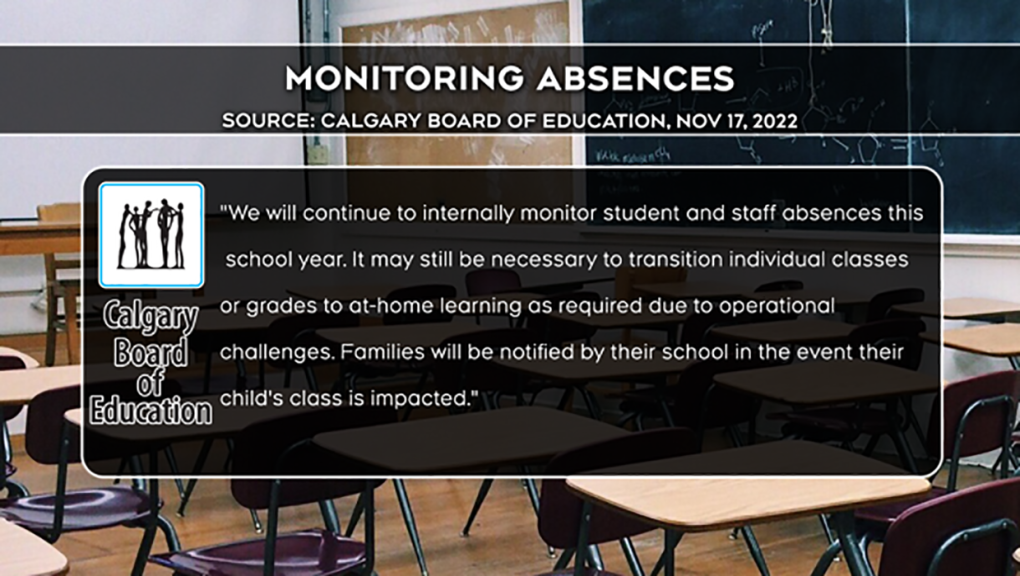
EXPERTS FIND WEAK EVIDENCES MASKS CAUSE HARM
Some Infectious diseases experts tell CTV News the data supporting mask-wearing is strong, but studies saying masks cause harm to children are flawed.
Dr. Stephanie Smith from the University of Alberta says there could be theoretical mental health impacts for children wearing masks, but there isn't compelling data to suggest there's a real threat.
"I think it's an area that's harder to study and to have rigorous evidence to point to say, absolutely, this is going to cause children under the age of five (will have) their speech and language be delayed," said Smith.
Other experts say there have been studies to analyze psychological symptoms like anxiety, stress, concentration and learning problems, but they failed to isolate mask-use from other impacts like school closures and canceled activities.
"When you look back at those studies, a lot of them were significantly biased by the fact that there were a lot of other restrictions going on at the same time," said Dr. Cora Constantinescu, pediatric infectious disease physician at Alberta Children's Hospital.
She adds that keeping children in school settings are proven to be beneficial, and says mask-use is a minor inconvenience to maximize in-person learning opportunities.
Craig Jenne, a U of C infectious diseases expert also agreed that the evidence masks decrease transmission and illness is strong.
"In the province of Alberta last year at this time, we had a lot of COVID-19 in the community, but we had masking in schools, the number of absentee days was dramatically lower."
Jenne continued, "Now without masks or other public health measures, even though we have less COVID in the community, we are seeing record numbers of absentee rates throughout the province. So it really points to that power of masks in reducing the chances you'll be exposed."
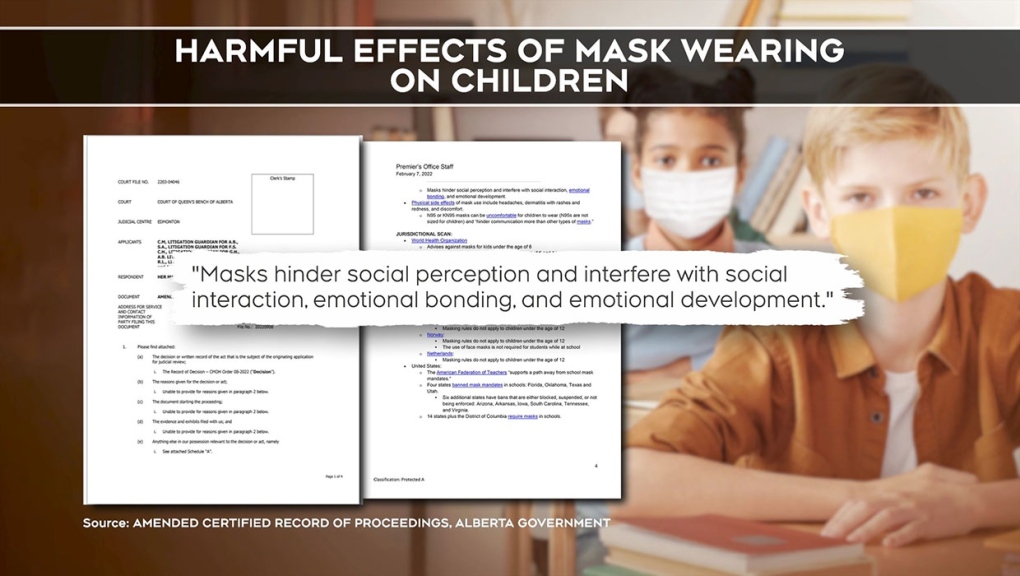
THE WAY FORWARD
The teachers' union says teachers are looking for clear guidance from political leaders.
"Teachers are looking for direction from government and from the chief medical officer in Alberta. And there's such a lack of information right now," said Jason Schilling, president of the Alberta Teachers' Association.
Constantinescu says Alberta families should consider increasing mask-wearing at school and in indoor social settings.
She also recommends Albertans of all ages get the available booster dose against COVID-19 and its variants, and to get the seasonal flu shot.
Advice to stay home when sick and to maintain hand hygiene continues to be important to protect against high rates of viral spread in Alberta.
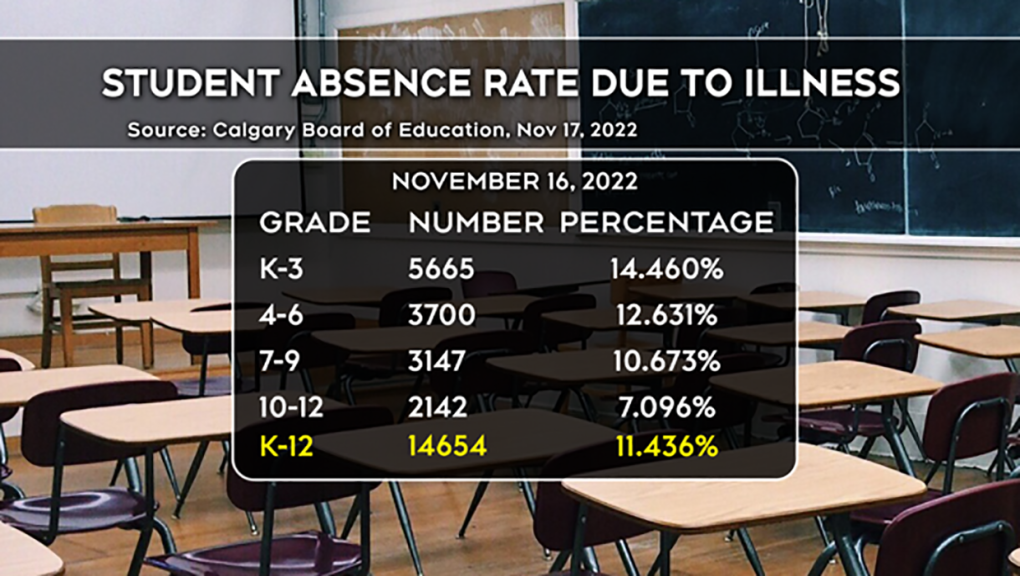
Overall, the board of education says 11 per cent of K-12 students are missing class for sickness.
By Emily Mertz Global News
Updated November 17, 2022

Alberta’s newly appointed top public health doctor released a statement about the rising number of respiratory viruses — flu, RSV and COVID-19 — circulating in the province.

Dr. Mark Joffe, who was named Alberta’s chief medical officer of health on Nov. 14, encouraged Albertans to get their flu shot and take other steps to reduce the spread.
READ MORE: Joffe to replace Hinshaw as Alberta’s chief medical officer of health: provincial government
He said Canada’s flu season usually mimics Australia’s, which has seen a severe respiratory virus season.
“In Australia, the highest rates of influenza disease were in children and teenagers, and children under 16 years of age accounted for the majority of influenza hospitalizations. Influenza can also have a severe impact on the elderly.
“While most children, youth and adults recover from the flu without complications, some can get very sick and need to be treated in hospital,” Joffe said in an emailed statement.

1:43 AHS says Albertans should put masks on as respiratory illness spreads
“We can expect to see similar outcomes in Alberta. Over the last few weeks, Alberta has seen an increase in reports of symptoms such as cough and fever in schools and daycares. We are monitoring the situation in schools closely,” Joffe’s statement continued.
“The province continues to transition back to longstanding practices to manage respiratory infections in general. That includes local public health officials notifying schools of outbreaks and giving them advice and support as needed.
“Transmission levels will fluctuate over time and between communities. We encourage Albertans to judge their risk at any point in time and take appropriate precautions.”
Since being named the new interim CMOH, Albertans have not heard from Joffe.
Several hospital executives held news conferences on Tuesday, addressing the spike in children’s respiratory illnesses, high numbers of Respiratory Syncytial Virus (RSV), early onset of the flu season, the Stollery Children’s Hospital being at capacity and long waits at Alberta emergency rooms.

The Edmonton Public School Board is also managing high absenteeism in schools with many children away sick. The board is contemplating asking the CMOH for specific advice and recommendations.
“I encourage Albertans to take simple, daily actions to help prevent the spread of respiratory viruses,” Joffe said, including:Stay home when feeling sick;Make the choice to stay up to date on your vaccinations, and speak to a physician or other care provider if you have questions about options;Wearing a well-fitting, high-quality mask can help reduce the risk of becoming sick and help protect others from being exposed. “Albertans should be supported regardless of their choice to mask or not,” he wrote.If possible, avoid close contact with people who are sick;Regularly clean hands with alcohol-based hand sanitizer or wash hands with soap and warm water for at least 20 seconds;Avoid touching eyes, nose or mouth with unwashed hands;Maintain good respiratory etiquette by covering coughs and sneezes;Avoid or limit time spent in crowded indoor places;Clean and disinfect frequently touched surfaces and items at home, especially when someone in your home is sick.
In a statement Wednesday, the City of Edmonton said: “City administration has not recommended consideration of a mask bylaw to city council recently. We are keeping an eye on the situation in Edmonton as cases of respiratory illness, COVID-19 and influenza rise.
“People are welcome to wear masks on transit and in city buildings, and since the most recent easing of health restrictions, we have been encouraging our employees to respect every person’s choice around mask wearing.”
A spokesperson for the City of Calgary said it is “carefully monitoring public health advice to help keep employees and members of the public safe and will not be making a recommendation to reintroduce a masking mandate at this time.
“The province amended the Municipal Government Act to expressly limit the authority of a municipality to enact a bylaw requiring masking. Such a bylaw is only valid if approved by the minister of Municipal Affairs.
“Legislation does, however, permit the city to pass a bylaw requiring masking on or in city-owned property.
“The city will continue to monitor the situation carefully, and collaborate closely with our partners at Alberta Health Services to align with their recommendations.
“We are encouraging city of Calgary employees to help fight viruses at home and at work by washing their hands regularly, cleaning as they go, and supporting the use of face masks as a personal choice. We encourage everyone in Calgary to take personal health actions to limit the spread of respiratory illnesses.”

1:41 Mask on or off? Mandatory face covering bylaw gone in Edmonton leaves people with choices to make
Joffe’s statement also included information about booking immunization appointments.
Albertans can book flu shots or COVID-19 boosters through the Alberta Vaccine Booking System or by calling Health Link at 811.
Some pharmacies also offer walk-in vaccinations.
Joffe’s biography page on the Alberta Health Services website says his “diverse clinical experience includes his specialty practice in infectious diseases.” The Calgary native has worked at the Royal Alexandra Hospital in Edmonton as well as at the Edmonton Sexually Transmitted Diseases Centre and the Edmonton Institution for Women.
Since becoming premier last month, Smith has said she would be replacing Hinshaw and finding new people to give her government advice on decisions related to public health.

0:38 Alberta Premier Danielle Smith says she will find new health officials for province
In a news release issued by the provincial government late Monday afternoon, Health Minister Jason Copping said Joffe “brings this wealth of experience and knowledge to the role of chief medical officer of health. I look forward to working with him.
“I also wish to thank Dr. Deena Hinshaw for her service and dedication to Albertans through the past several years.”
The government noted Joffe will continue to work under his current contract with AHS and not receive any additional compensation for his new role.
In a news conference earlier Wednesday addressing the rising number of respiratory illnesses, Opposition NDP leader Rachel Notley said Albertans deserved to hear updates and plans from the premier, health minister and CMOH.
“We’ve got school boards, for instance, here in Edmonton desperately calling on the provincial government and particularly the chief medical officer of health to provide more fulsome information on the state of outbreaks across the board, as well as specific recommendations for how best to keep our kids safe and also about what we can expect going forward. And we’re not getting that kind of information,” Notley said.
“We have a serious infectious disease outbreak impacting our kids to the point that we have 12-hour lineups at children’s emergency rooms and we don’t seem to have anybody who thinks it’s their job to step up and address the matter.
“No one is in charge. As a result, no one is responsible. No one is providing leadership. No one is protecting the health and safety of our kids across this province and that’s a complete failure of leadership.”
Notley also said the firing of Hinshaw and appointment of Joffe as the new interim CMOH sends a message.
“We have a chief medical officer of health who, although a very credible human being, is not actually even being paid to do the job. And he’s still doing his other complete job. So that sounds to me like we’ve got a government that doesn’t really value that role.
“Moreover, the previous chief medical officer of health was literally fired because they didn’t agree politically with the scientific evidence she was putting forward or trying to put forward,” Notley said.
“We have a new acting chief medical officer of health has actually has a gargantuan range of responsibilities in his current job who’s been given no time and no extra money to do this whole other job.”


